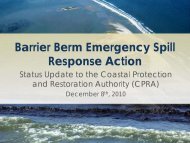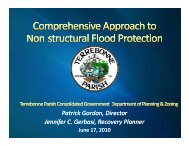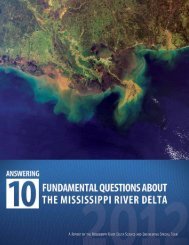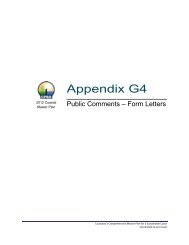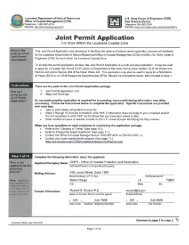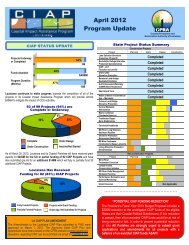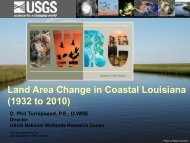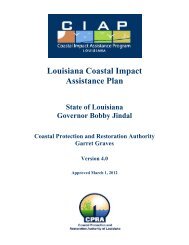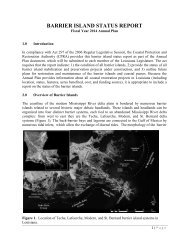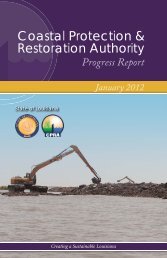Largemouth Bass Habitat Suitability Index Technical Report
Largemouth Bass Habitat Suitability Index Technical Report
Largemouth Bass Habitat Suitability Index Technical Report
Create successful ePaper yourself
Turn your PDF publications into a flip-book with our unique Google optimized e-Paper software.
APPENDIX D‐9 LARGEMOUTH BASS HABITAT SUITABILITY INDEX TECHNICAL REPORT(32 and 64 bit), Apple OSX (32 and 64 bit), Linux. Furthermore, these Java executables could beeasily re‐compiled to run on Windows or Linux Application Servers.d. Description of process used to test and validate modelModel output validation occurred at two points in the process. As described previously, fourdata collections were compared to model predictions in a cross‐validation type approach.Secondly, visual inspection of the model output by the author and representatives of CPRAcompared to known largemouth bass distributions suggested improvements, and followingimprovements, model success in prediction. The model output also was exhibited to arepresentative of the U.S. Fish and Wildlife Service, who generally agreed with the outputexcept for the coarse size of some polygons which may yield deceptive distributions near MarshIsland. Because the polygon sizes are set by other working groups, this valid criticism is notactionable.e. Discussion of the ability to import data into other software analysis tools (interoperabilityissue)Being standards compliant with international modeling data standards ensures rather broadinteroperability. Unidata actively supports netCDF read/write libraries for C++, Java, C# andFortran programming languages across multiple operating systems. Additionally, netCDF isnatively consumable by commercial software product such as ESRI ArcMAP and MatLab.Furthermore, the Everglades Joint Ecologic Modeling community has backed a USGS softwaredevelopment effort resulting in EverVIEW which brings an open‐source visualization platformsolution to the complex realm of binary modeling data.4. Usabilitya. Availability of input data necessary to support the modelThe model requires readily available or predictable temperature, salinity, emergent vegetation,submerged vegetation, and chlorophyll a data. The input files required to run this model areavailable through the CPRA.b. Formatting of output in an understandable mannerThe output data is a suitability index ranging from 0.0 to 1.0 that represents the potential foragriculture/aquaculture of a 500 x 500m model grid cell. The output files are in netCDF formatand can be viewed using EverVIEW or ArcGIS.c. Usefulness of results to support project analysisSpecifically, large changes in the predicted HSI values reflect changes in salinity. Salinity eithercauses aquatic habitats to become unsuitable by becoming excessively high, which causes directmortality for largemouth bass, or by altering vegetation such that the vegetation no longersupports cover and forage needs of largemouth bass. If land loss occurs through coastal erosionand/or salinity increases through saltwater intrusion, habitat suitability will decrease and,eventually, reach zero. If aquatic habitats are fresh and remain fresh, suitability will remainmoderate to high. If saline habitats freshen below 12 ppt, suitability will increase and willincrease more dramatically if salinity falls below 8 ppt. Given these responses to changes insalinity directly and through vegetation, largemouth bass are an ideal organism to evaluateincreases and decreases in salinity as a result of various restoration and protection projects.Diversion, pumps, levee notches or breaches, or other projects that add freshwater to coastalmarshes should increase habitat suitability in adjacent cells and polygons and may increase theLouisiana’s Comprehensive Master Plan for a Sustainable CoastPage 13



